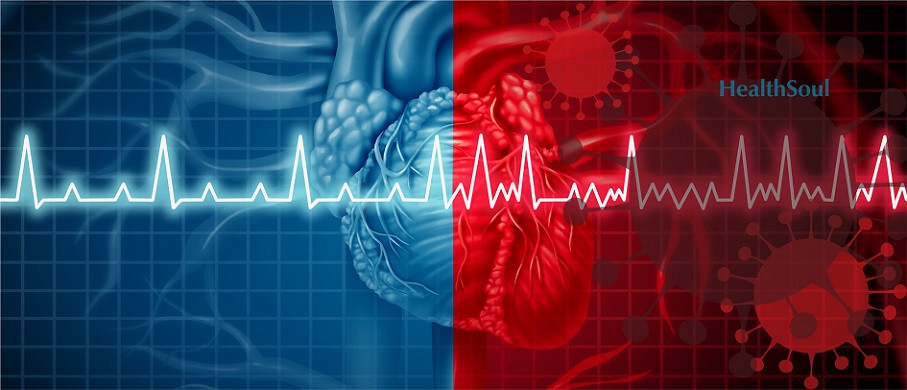Coronarvirus and the Heart: How to protect yourself?

Coronavirus cases continue to rise, affecting close to 27.6 Million people worldwide and causing 900,000 deaths. As of September 10th, USA has 6.37 Million cases and India has 4.45 million cases. We hope to contrast the healthcare systems in India and US in terms of cardiovascular care when these two countries are at different stages of the pandemic. We have interviewed Dr. Sameer Gupta, Cardiologist in India and Dr. Ish Singla, Cardiologist in USA to discuss about care of patients with heart disease in the time of coronavirus.
India has reached close to 4,450,000 tested positive coronavirus cases while ramping up testing capacity and cautiously re-opening businesses after lockdown of 8-12 weeks. Let me start by asking you about common symptoms of this viral infection?
The symptoms can vary from no symptoms to fever, cough, fatigue, shortness of breath, sore throat, headache, chills, loss of sense of taste/smell.

Though this is a respiratory virus, does it affect the heart too?
I wish to emphasize that though this is a respiratory spread virus its effects are far outreaching on human body than respiratory system only. A systemic inflammatory response by body causes mild to severe dysfunction of all organs including heart. Mild Troponin elevation in blood which typically indicates death of heart cells though commonly seen with COVID 19 is not equivalent to heart attack likely caused by inflammation of the cardiac tissue called myocarditis.

Is there any evidence of more damage with COVID infection in patients taking blood pressure pills in the category of ACE/ARB inhibitors such as lisinopril and losartan?
No, patients should continue to take these medications as advised by their physicians.
How about statins like atorvastatin/Lipitor?
While there are studies trying to find if statin may be beneficial and this is still subject of investigations; there is no evidence of harm.
US has seen more than 180,000 deaths – what is the mortality rate of COVID infection in hospitalized patients with cardiovascular diseases?
There is a spectrum of cardiovascular diseases and while it may be less than 1% in those young and with high blood pressure only to 10% in those with previous heart attack or stent; it may approach 20% in those with heart failure and low pumping capacity of heart.
Do you think there are lower number of patients with major heart attacks (STEMI) during lockdown due to this pandemic?
Yes, we are seeing less patients with STEMI, recently. A major survey showed that about 80% hospital respondents see a 50% decline in patient presenting with STEMI. While, a small proportion of this may be change in lifestyle and medication compliance, there are a lot of late presentation. About 2 out of 3 patients have presented late. I have seen a lot of patients recently who have completed a myocardial infarction as they were scared about coming to the hospital.
Have surgeries such as bypass surgery or pacemakers or heart catheterizations been delayed in India due to this virus?
“Elective surgeries” have been delayed. However, it is of note that we treat heart attacks, and patients with unstable angina which is not elective and thus a small proportion of patients are being treated.
Has the cardiologists started back on elective cardiac cath and surgeries as the pandemic seems to have slowed down in US?
Yes, we have resumed these procedures. We have strict screening protocols based on clinical symptoms and if needed testing to reduce exposure to healthcare workers.
Has management of heart attacks changed now?
While, many in China have adopted the strategy of using clot buster medications in patients with COVID and AMI; primary angioplasty remains cornerstone. This has required extensive training of staff re: isolation and protection, separate Cath lab designed for PUI or COVID patients, additional time and attention for strong confirmation of both diagnosis and prognosis of the patient. Pt. with low risk of COVID or strong indication that cath will benefit them and would alter short term prognosis are brought to the cath lab.
What can a cardiologist do to safeguard the health of their patients?
The focus is prevention of transmission and education. If you are directly caring for COVID patients or PUIs, then avoid contact with older adults. Continue all medications. Educate about hydration, daily exercise, and good nutrition.Use of telehealth for routine visits. Very strong emphasis on preventive care and availability of DAPT, DOACs.
United States has seen limited staff numbers due to system overload, school closure, and now furloughs and lay-offs due to stopping of elective procedures?
Reopening in cautious and systematic way is important to avoid crippling of healthcare and economy in general. As time passes, patients who have been deferred appropriate treatment for weeks now will start to slowly show deterioration such as patients with severe aortic valve stenosis. Those requiring pacemakers and revascularization. Having antibody testing phased in will help with this as well.
What is the best treatment?
Prevention is the best treatment. There is some hope for very sick patient of some improvement with Remdesevir; and new synthetic antibody is on horizon while phase I testing for multiple vaccines and ramping up pre-production efforts are ongoing. At this time, social distancing, wearing personal protection equipment will stay in place and we need to not let complacency come into this.

